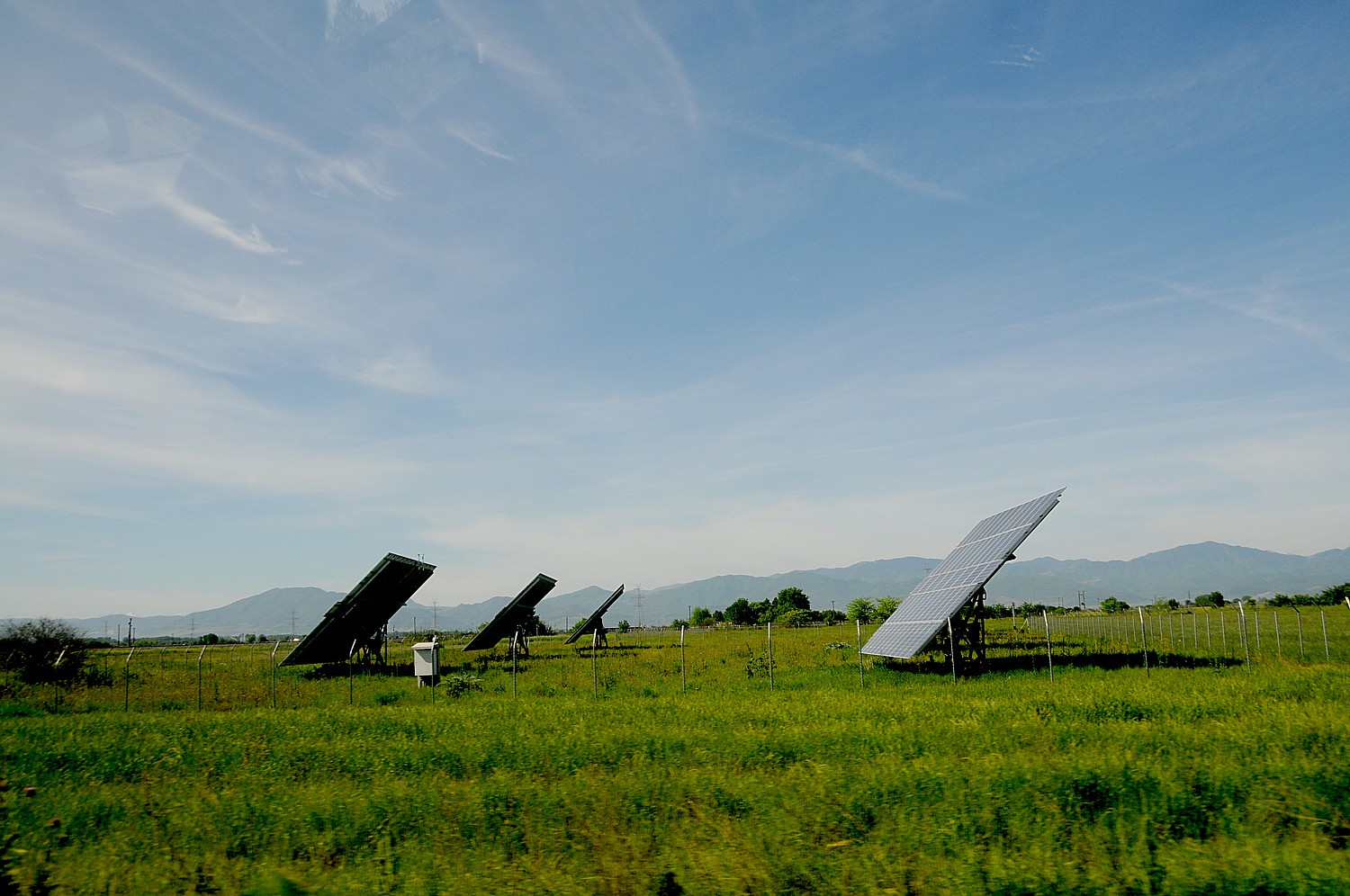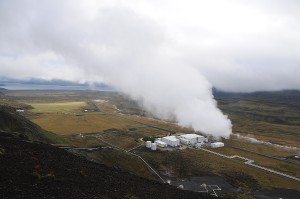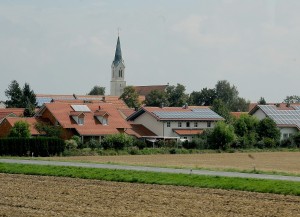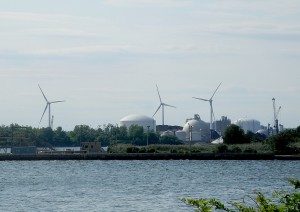
by Karen Rubin/News & Photo Features
The fact that nearly 200 countries–representing nearly the entire population of Earthlings–have signed on to the Paris Climate Agreement, pledging to take climate action is, as President Obama said, “a turning point for the world.”
“Together, we’ve shown what’s possible when the world stands as one,” he said in a statement from the White House, December 12:
“Today, the American people can be proud — because this historic agreement is a tribute to American leadership. Over the past seven years, we’ve transformed the United States into the global leader in fighting climate change. In 2009, we helped salvage a chaotic Copenhagen Summit and established the principle that all countries had a role to play in combating climate change. We then led by example, with historic investments in growing industries like wind and solar, creating a new and steady stream of middle-class jobs. We’ve set the first-ever nationwide standards to limit the amount of carbon pollution power plants can dump into the air our children breathe. From Alaska to the Gulf Coast to the Great Plains, we’ve partnered with local leaders who are working to help their communities protect themselves from some of the most immediate impacts of a changing climate.”
And doing it all while breaking all records for the longest streak of private sector job creation. “We’ve driven our economic output to all-time highs while driving our carbon pollution down to its lowest level in nearly two decades,” Obama said.
Speaking to detractors are both sides – climate activists who said the agreement does not go far enough, and climate deniers who would reject any action at all, he said, “Now, no agreement is perfect, including this one. Negotiations that involve nearly 200 nations are always challenging. Even if all the initial targets set in Paris are met, we’ll only be part of the way there when it comes to reducing carbon from the atmosphere. So we cannot be complacent because of today’s agreement. The problem is not solved because of this accord. But make no mistake, the Paris agreement establishes the enduring framework the world needs to solve the climate crisis. It creates the mechanism, the architecture, for us to continually tackle this problem in an effective way.
“This agreement is ambitious, with every nation setting and committing to their own specific targets, even as we take into account differences among nations. We’ll have a strong system of transparency, including periodic reviews and independent assessments, to help hold every country accountable for meeting its commitments. As technology advances, this agreement allows progress to pave the way for even more ambitious targets over time. And we have secured a broader commitment to support the most vulnerable countries as they pursue cleaner economic growth.
“In short, this agreement will mean less of the carbon pollution that threatens our planet, and more of the jobs and economic growth driven by low-carbon investment. Full implementation of this agreement will help delay or avoid some of the worst consequences of climate change, and will pave the way for even more progress, in successive stages, over the coming years.
“Moreover, this agreement sends a powerful signal that the world is firmly committed to a low-carbon future. And that has the potential to unleash investment and innovation in clean energy at a scale we have never seen before. The targets we’ve set are bold. And by empowering businesses, scientists, engineers, workers, and the private sector — investors — to work together, this agreement represents the best chance we’ve had to save the one planet that we’ve got.
“So I believe this moment can be a turning point for the world. We’ve shown that the world has both the will and the ability to take on this challenge. It won’t be easy. Progress won’t always come quick. “We cannot be complacent. While our generation will see some of the benefits of building a clean energy economy — jobs created and money saved — we may not live to see the full realization of our achievement. But that’s okay. What matters is that today we can be more confident that this planet is going to be in better shape for the next generation. And that’s what I care about…..our work today prevented an alternate future that could have been grim; that our work, here and now, gave future generations cleaner air, and cleaner water, and a more sustainable planet. And what could be more important than that?
“Today, thanks to strong, principled, American leadership, that’s the world that we’ll leave to our children — a world that is safer and more secure, more prosperous, and more free. And that is our most important mission in our short time here on this Earth.
Significantly, the United States, whose Republican rightwingers are the smallest, tiniest minority of 7 billion souls, opted for language – “should” rather than “shall” – in order to bypass the need for Senate ratification of an actual treaty. We’ve seen how treaties, as benign as making America’s standards for disabled people, have been rejected, and the GOP Majority made it clear they would do everything possible – even shutting down the government – to make sure the United States does not do its part. It is notable that the United States represents a mere 5% of the world’s population, but is responsible for 25% of the emissions that are causing climate change. China, the second largest emitter, has four times the population but during the Paris talks, had to issue its first ever Red Alert because air quality was too dangerous due largely to emissions from coal-fired plants.
Without missing a beat, Republican Congressional leaders said they would block whatever action Obama promised, based on the idea that the President “made promises he can’t keep.”

But as Secretary of State John Kerry responded, 195 countries in the world have signed on to this historic agreement, bringing their own strategies and solutions to the table so they are more likely to follow through (much as the Obama Administration allowed states to develop their own Clean Power Plan solutions, and their own Affordable Care Act solutions). Essentially he is saying that the Republicans are on the wrong side of history, or just plain wrong.
This was the genius of Obama’s strategy, going back to forging a historic joint announcement with China last year that “showed it was possible to bridge the old divides between developed and developing nations that had stymied global progress for so long,” the President said. “That accomplishment encouraged dozens and dozens of other nations to set their own ambitious climate targets. And that was the foundation for success in Paris. Because no nation, not even one as powerful as ours, can solve this challenge alone. And no country, no matter how small, can sit on the sidelines. All of us had to solve it together.”
He also has managed to bring along many of the world’s most influential companies (not Koch Industries, of course), and billionaires (not the Koch Brothers, of course, who are spending their billions buying sycophant politicians), who are pledged to invest in climate action strategies including developing clean, renewable energy technologies that will shift our economy from its dependence on burning dirty fossil fuels (that’s what has the Koch brothers really worried).

But now, it is key that the vast majority of us who want climate action push for Congress (that means getting the GOP to stop blocking) to reauthorize the tax credits for renewable energy industries – solar and wind, in particular – to get a foothold. Solar industry is the fastest growing in the US. This is jobs creation. This is giving households more disposable income by bringing down the cost being extorted for fossil fuels (is anyone giving Obama credit for the fact that gas prices are likely to fall below $2 a gallon for the first time since 2007, as they blamed him when gas prices rose to nearly $5?). This is making communities more energy independent.
You would think that Republicans, whose singular economic policy consists of cutting taxes, especially corporate taxes and taxes that go to the wealthy, would be in favor of tax credits to spur a fledgling industry. But this is clean, renewable energy that threatens the profits and the power of the Old Fossils.
Current legislation could extend the renewable energy production tax credit for wind energy that expired a year ago. Environmentalists are also pushing for the extension of the solar investment tax credit which is set to be significantly reduced next year. And for those GOPers who suggest that the federal government “shouldn’t pick winners and losers” – they refuse to rescind the billions of dollars in subsidies that still flow to fossil fuels (or for that matter, the legislative advantages that are given, in terms of licensing and liability), despite the fact these are some of the most profitable companies in the history of humankind. Here’s a compromise: they should condition those subsidies to Exxon-Mobil, etc. on only what they spend to develop and implement clean, renewable fuels (and not natural gas, which is their big new product).

“Subsidies to fossil fuels do not expire. Neither should incentives for clean energy. Clean energy is one of America’s fastest growing industries, creating homegrown, well-paying jobs across the country—but failure to extend these tax credits could seriously set back that progress,” stated Heather Shelby Action Network Manager for Environmental Defense Fund Action.
EDF is urging people to contact Congress and urge they support for:
* An extension of the renewable energy production tax credit for wind and other renewable energy technologies, which expired at the end of 2014.
* An extension of the tax incentives for residential and commercial energy-efficient construction, which expired at the end of 2014.
* An extension of the solar investment tax credit for residential and commercial properties, which will be greatly reduced in 2017.
So what’s in the Paris Agreement? The White House produced a Fact Sheet, breaking it down
FACT SHEET: U.S. Leadership and the Historic Paris Agreement to Combat Climate Change
Today, more than 190 countries came together to adopt the most ambitious climate change agreement in history. The Paris Agreement establishes a long term, durable global framework to reduce global greenhouse gas emissions. For the first time, all countries commit to putting forward successive and ambitious, nationally determined climate targets and reporting on their progress towards them using a rigorous, standardized process of review.
The Agreement provides strong assurance to developing countries that they will be supported as they pursue clean and climate resilient growth. The deal builds on the unprecedented participation of 187 countries that submitted post-2020 climate action targets in advance of the meeting, and establishes a framework to ratchet up ambition by driving down global emissions in the decades to come.
This new global framework lays the foundation for countries to work together to put the world on a path to keeping global temperature rise well below 2 degrees Celsius and sets an ambitious vision to go even farther than that. This Agreement sends a strong signal to the private sector that the global economy is moving towards clean energy, and that through innovation and ingenuity, we can achieve our climate objectives while creating new jobs, raising standards of living and lifting millions out of poverty.
The Paris Agreement is also the culmination of a broader effort by nations, businesses, cities, and citizens to reorient the global economy to a path of low-carbon growth – progress that will accelerate as a result of the Agreement’s provisions on mitigation ambition, transparency, and climate finance.
An Ambitious Agreement
The Paris Agreement sets forward an ambitious vision for tackling climate change globally. This includes:
- Strengthening long-term ambition:The Agreement sets a goal of keeping warming well below 2 degrees Celsius and for the first time agrees to pursue efforts to limit the increase in temperatures to 1.5 degrees Celsius. It also acknowledges that in order to meet that target, countries should aim to peak greenhouse gas emissions as soon as possible.
- Establishing a universal approach for all countries:The Agreement moves beyond dividing the world into outdated categories of developed and developing countries and instead directs all parties to prepare, communicate and maintain successive and ambitious nationally determined climate targets. This approach – where countries set non-binding targets for themselves – paved the way for 187 mitigation contributions this year and will form the basis for a long-term, durable system to ratchet down emissions.
- Locking in five year target cycles:Under the Agreement, all countries will communicate their climate targets every five years, starting in 2020. Targets must be submitted 9-12 months before they are finalized, creating time for other countries and civil society to seek clarity about the targets submitted.
- Ratcheting up ambition over time:Each target should reflect progress from the prior one, reflecting the highest possible ambition that each country can achieve. This durable, long term framework will drive greater climate ambition as technologies improve and circumstances change.
- Rigorous assessment of global climate action:To help inform further domestic and global efforts, the Agreement puts in place a mechanism to assess collective progress on global mitigation action using the best available science. This process will begin in 2018 and occur every five years to help inform countries’ future targets and strategies.
- Sending a market signal on innovation and technology:The mitigation components of the Agreement, combined with a broad push on innovation and technology, will help significantly scale up energy investments over the coming years – investments that will accelerate cost reductions for renewable energy and other low-carbon solutions. This set of actions will create a mutually reinforcing cycle in which enhanced mitigation increases investment and enhanced investment allows additional mitigation by driving down costs.
A Transparent and Accountable Agreement
The Paris Agreement establishes a robust transparency system to help make sure that all countries are living up to their commitments. This will send a market signal to the private sector and investors that countries are serious about meeting the targets they have set. These steps include:
- Putting in place an enhanced transparency system for all countries:A critical component of the Agreement, the transparency framework agreed to by parties ensures that all countries are on a level playing field with the United States with flexibility for those developing countries with less capacity.
- Requiring countries to report on greenhouse gas inventories: For the first time, the Agreement requires all countries to report on national inventories of emissions by source. This breakthrough will give unprecedented clarity to the public’s understanding of emissions and pollution in countries throughout the world.
- Requiring countries to report on mitigation progress:Also for the first time, countries are required to report on information necessary to track progress made in implementing and achieving the targets and strategies countries have put forward.
- Establishing a technical review process with agreed upon standards:To help ensure countries are meeting transparency requirements, countries are subject to a comprehensive technical expert review process that analyzes whether reporting is in line with the standards adopted. Countries will also engage in a multilateral review with their peers to share their experiences and lessons learned.
An Agreement for a Low-Carbon Future
Tackling climate change will require shifting global investment flows towards clean energy, forest protection, and climate-resilient infrastructure. Developing countries, particularly the most vulnerable, will need support from the global community as they pursue clean and resilient growth. The Paris Agreement makes real progress on this front by:
- Providing a strong, long-term market signal that the world is locking in a low-carbon future:The submission of ambitious national targets in five-year cycles gives investors and technology innovators a clear signal that the world will demand clean power plants, energy efficient factories and buildings, and low-carbon transportation not just in the short-term but in the decades to come. This will make it far easier to draw in the largest pools of capital that need long-term certainty in order to invest in clean technologies.
- Giving confidence that existing financial commitments will be met:Many developing countries, particularly the poorest and most vulnerable, came to Paris seeking reassurance that a global climate deal is not just about the big emitters but also supports their transition to a low-carbon growth path. In this regard, we are already making strong progress towards meeting the existing goal to mobilize $100 billion from a wide variety of sources, including both public and private, by 2020. The Paris outcome provides further confidence that this goal will be met and that climate finance will continue to flow. For the first time, the Agreement recognizes the reality that countries like China are already joining the base of donor countries contributing to climate finance and encourages developing countries to contribute to climate finance, while reaffirming that the United States and other developed economies should continue to take the lead.
These components of the Agreement build on steps the United States took in Paris to demonstrate its commitment to mobilizing finance from public and private sources for both mitigation and adaptation activities in developing countries. These steps include:
- Launching Mission Innovation:On the first day of the conference, President Obama joined other world leaders to launch Mission Innovation, a landmark commitment to accelerate public and private global clean energy innovation, and dramatically expand the new technologies that will define a clean, affordable, and reliable global power mix. Twenty countries representing around 80% of global clean energy research and development (R&D) funding base committed to double their R&D investments over five years. In addition, a coalition of 28 global investors led by Bill Gates committed to support early-stage breakthrough energy technologies in countries that have joined Mission Innovation.
- Doubling U.S. grant-based public finance for adaptation by 2020: Secretary of State John Kerry announced that the United States will double its grant-based, public climate finance for adaptation by 2020. As of 2014, the United States invested more than $400 million per year of grant-based resources for climate adaptation in developing countries. These investments provide vulnerable countries with support – through both bilateral and multilateral channels – to reduce climate risks in key areas, including infrastructure, agriculture, health and water services.
An Agreement Complemented by Subnational, Private Sector and Citizen Action
Because the Agreement should serve as a floor for future ambitious climate action, complementary actions outside of the Agreement by sub-national governments, enterprising businesses, investors and entrepreneurs, and an enlightened global public are important complements to the Paris Agreement. As part of these global efforts, Americans have demonstrated their dedication to climate action through a wide variety of commitments.
- Compact of Mayors:117 United States mayors have signed onto the Compact of Mayors pledge. The Compact establishes a common platform to capture the impact of cities’ collective actions through standardized measurement of emissions and climate risk, and consistent, public reporting of their efforts.
- Under-2 MOU:States including California, Oregon, Vermont, Washington, Minnesota, New Hampshire, and New York have signed onto the Under-2 MOU. The MOU commits signatories to cut greenhouse gas emissions 80-95% below 1990 levels, share technology and scientific research, expand zero-emission vehicles, improve air quality by reducing short-lived climate pollutants and assess projected impacts of climate change on communities.
- American Business Act on Climate Pledge:154 companies have signed the White House’s American Business Act on Climate Pledge. These companies have operations in all 50 states, employ nearly 11 million people, represent more than $4.2 trillion in annual revenue and have a combined market capitalization of over $7 trillion. As part of this initiative, each company expressed support for an ambitious Paris Agreement and announced significant pledges to reduce their emissions, increase low-carbon investments, deploy more clean energy and take other actions to build more sustainable businesses and tackle climate change.
- American Campuses Act on Climate Pledge:311 colleges and universities representing over 4 million students have demonstrated their commitment to climate action by joining the American Campuses Act on Climate Pledge.
______________
© 2015 News & Photo Features Syndicate, a division of Workstyles, Inc. All rights reserved. For editorial feature and photo information, go to www.news-photos-features.com, email krubin723@aol.com. ‘Like’ us on facebook.com/NewsPhotoFeatures, Tweet @KarenBRubin
